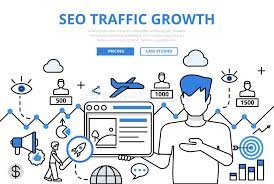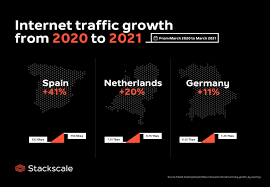In the fast-paced world of digital marketing, staying ahead of SEO trends is crucial to maintaining and growing website traffic. As search engines evolve, so do the strategies that drive visibility and organic reach. In 2025, SEO is no longer just about keyword rankings; it’s about delivering a seamless user experience, prioritizing content quality, and building authority within your niche.
If you’re looking to maximize your website’s traffic growth in 2025, this guide will walk you through the most effective SEO strategies that will help your site stand out and climb the ranks on search engines.
1. Focus on User Experience (UX) and Core Web Vitals
Google has made it clear that user experience is a priority. In 2025, Core Web Vitals, a set of metrics that measure the loading speed, interactivity, and visual stability of your website, will continue to play a major role in SEO rankings. Websites with a poor user experience will see a dip in rankings, while sites that prioritize fast loading times and smooth navigation will get rewarded.
To enhance user experience:
- Optimize page load speed: Use tools like Google PageSpeed Insights or GTMetrix to analyze your site’s performance and identify areas for improvement.
- Improve mobile-friendliness: With mobile traffic surpassing desktop users, ensuring that your site is responsive and optimized for mobile devices is a must.
- Focus on intuitive navigation: Make sure your site is easy to navigate, with clear CTAs and a logical structure.

2. Prioritize High-Quality, Relevant Content
Content has always been king in the world of SEO, and it will remain a key factor in 2025. However, search engines are getting better at determining not just the quantity of content but its quality and relevance. Simply stuffing a page with keywords no longer cuts it; you need to provide value and address user intent.
To create high-quality content:
- Create comprehensive, in-depth articles: Google’s algorithms favor longer, more detailed content that fully answers a user’s query. Aim for content that addresses topics from multiple angles and includes statistics, case studies, and examples.
- Understand search intent: Make sure your content matches the intent behind the search queries. This means understanding whether a user is looking for informational, navigational, or transactional content.
- Use semantic keywords: Instead of focusing solely on exact-match keywords, use semantically related keywords and phrases. This helps you rank for a wider variety of search terms.
3. Optimize for Featured Snippets and Position Zero
Featured snippets, also known as “position zero,” are a valuable source of traffic. These are the boxes that appear at the top of search results, offering users quick answers to their queries. Optimizing for featured snippets can significantly boost your visibility and traffic.
To optimize for featured snippets:
- Structure your content for snippets: Use clear headings, bullet points, and numbered lists. Snippets often pull information from well-organized, concise content.
- Answer common questions: Include a FAQ section or target question-based keywords. For example, if you’re writing about SEO, consider targeting queries like “What is SEO?” or “How does SEO work?”
- Use schema markup: Implementing structured data helps search engines understand the content better, making it more likely to be featured in rich snippets.
4. Leverage Video Content for SEO
Video content continues to rise in importance for SEO and user engagement. With platforms like YouTube being the second largest search engine, video is an excellent way to drive traffic. Google also often pulls video results for search queries, giving video content a prominent position in search results.
To leverage video for SEO:
- Optimize video titles, descriptions, and tags: Make sure your video content is fully optimized with relevant keywords and descriptions that align with the content on your website.
- Host videos on your site: Embed videos directly on your website to increase engagement and decrease bounce rates.
- Transcribe your videos: Adding transcriptions makes your video content more accessible to a wider audience and provides Google with more text to index.
5. Build High-Quality Backlinks
While content and technical SEO are vital, backlinks still remain one of the most powerful ranking factors in SEO. Earning high-quality backlinks from authoritative sites signals to Google that your content is credible and valuable.
To build backlinks:
- Guest blogging: Writing guest posts for authoritative websites in your niche is a great way to build backlinks and drive traffic.
- Create shareable content: Infographics, in-depth guides, and research studies are highly shareable. Create content that others will want to link back to.
- Reach out for link-building opportunities: Don’t hesitate to reach out to websites that may benefit from linking to your content. Always focus on quality over quantity.

6. Capitalize on Local SEO
If your business has a physical location or serves a specific geographic area, local SEO should be a top priority. Google continues to prioritize local search results, and appearing in the local pack (the map section of search results) can provide significant traffic growth.
To improve local SEO:
- Claim and optimize your Google My Business profile: Ensure that your profile is complete, accurate, and up-to-date.
- Encourage customer reviews: Positive reviews on Google and other platforms help improve local rankings and build trust with potential customers.
- Local backlinks: Get backlinks from local businesses, chambers of commerce, or local news outlets to strengthen your local SEO.

7. Embrace Artificial Intelligence (AI) and SEO Tools
AI and automation tools are reshaping the SEO landscape. In 2025, AI tools can help streamline content creation, keyword research, and SEO audits, making it easier for businesses to stay ahead.
To incorporate AI into your SEO strategy:
- Use AI for content research and ideation: Tools like ChatGPT can assist in brainstorming topics and generating content outlines.
- Utilize AI-powered SEO tools: Platforms like Clearscope or Surfer SEO use AI to help optimize your content for better rankings.
Conclusion
Maximizing your traffic growth in 2025 requires staying up-to-date with evolving SEO trends. By focusing on user experience, high-quality content, featured snippets, video optimization, backlinks, local SEO, and leveraging AI, you can ensure that your website stands out in the competitive digital space.
SEO is a long-term strategy, but with the right approach, you can build a sustainable flow of organic traffic and see measurable growth year after year.
Related Tags:
- SEO Strategies 2025
- Traffic Growth Tips
- Core Web Vitals
- Featured Snippets SEO
- Video SEO Optimization
- Local SEO Best Practices
- Backlink Building Tips
- Content Marketing for SEO
- User Experience in SEO
- AI in SEO













